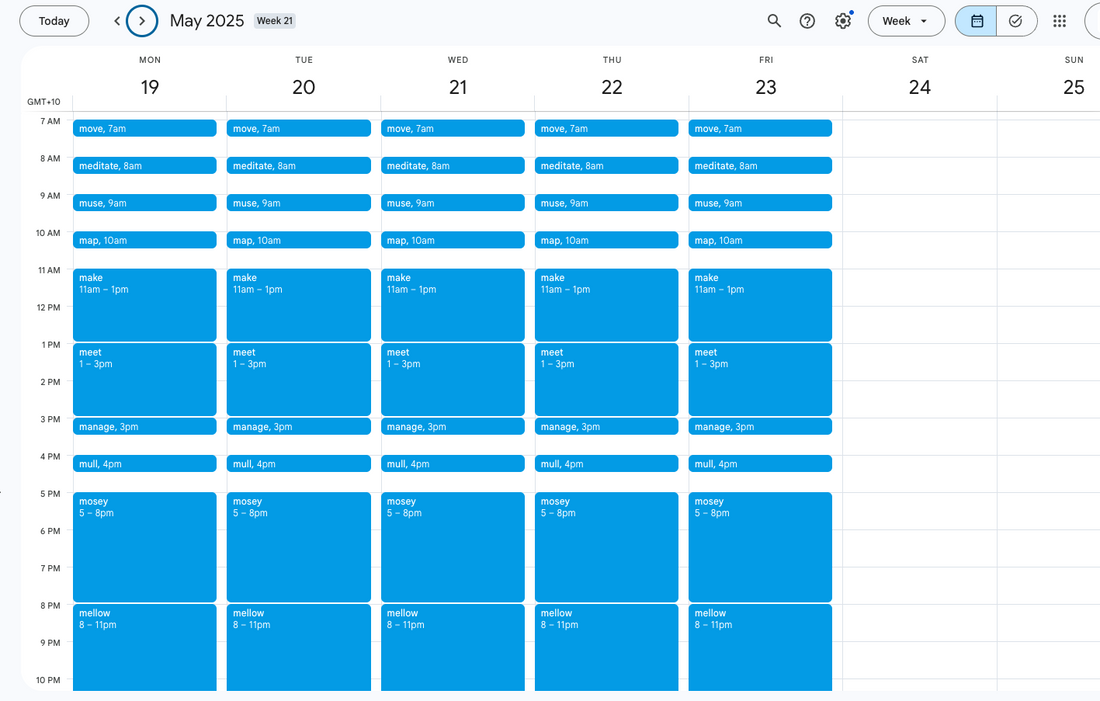
The 10 'M' day, a healthy daily rhythm
Share
Here is a new workday rhythm I'm striving for. Imagine if we synced up our teams and organisations so that we could support each other to move gracefully through these phases each day. I know this is potentially a pipe dream for many who can't control much of their workdays, but I thought sharing some elements of an ideal day might be helpful to some.
- Move (0.5 to 1 hour, sometime between 5am and 8am)
- Meditate (0.5 to 1 hour, sometime between 6am and 9am)
- Muse (0.5 to 1 hour, sometime between 6am and 10am)
- Map (0.5 to 1 hour, sometime between 7am and 11am)
- Make (1 hour to 4 hours, sometime between 9am and 3pm)
- Meet (0.5 to 4 hours, sometime between 10am and 3pm)
- Manage (0.5 to 2 hours, sometime between 11am and 4pm)
- Mull (0.5 to 1 hour, sometime between 12pm and 5pm)
- Mosey (1 to 4 hour, sometime between 3pm and 9pm)
- Mellow (0.5 to 1 hour, sometime between 5pm and 10pm)
Here is a breakdown of what I aim to do in each time slot. Keep in mind, the timing of these phases changes everyday based on the needs of my kids, family, or other unmovable commitments. They can be earlier or later and shorter or longer depending on the needs of any given day. But generally, if I can do at least half an hour of each, its a good day.
- Move - this is about mobility, flexibility, strengthening, and stretching. It is about getting the blood flowing and working out somatic tension. It helps us to release and open up physically and mentally. One of the main purposes of yoga is to prepare the body to meditate ("A Beginner's Guide to Meditation." Yoga Journal).
- Meditate - this is about becoming present and grounding ourselves. It is about become aware of our inner and outer senses. It is about letting go of mental tension and anxiety about the past or future. It is about entering the here and now as much as possible. It is opening to the moment. A state of mind we should try to hold onto throughout the day. ( Jha, A. P., Kromrei, T. O., & Baime, M. J. (2007). Mindfulness training modifies subsystems of attention. Cognitive, Affective, & Behavioral Neuroscience, 7(2), 109–119.)
- Muse - this is about allowing the mind to wonder and explore and express. It is allowing it to clear itself of its pent up thoughts and emotions. One way is to freewrite or journal. To just write stream of consciousness everything that comes into your mind no matter how silly, mundane, or deep and profound. We are still letting go and letting it all out. We are still opening ourselves up to be vulnerable and curious throughout the day. This give us an opportunity for authentic connection and insights. (Cameron, Julia. (2002). The Artist's Way: A Spiritual Path to Higher Creativity. Jeremy P. Tarcher/Putnam and Elbow, Peter. (1998). Writing Without Teachers. Oxford University Press.)
- Map - this is about starting to focus and plan our day. We start to concentrate and channel our mind and body to prioritise and order what is most important. With a clear map or plan we can deeply focus on whatever we are doing in the day knowing there is a time and place for all we want to achieve. (J Appl Psychol. 2018 Mar;103(3):300-312. doi: 10.1037/apl0000278. Epub 2017 Nov 20. When daily planning improves employee performance: The importance of planning type, engagement, and interruptions. J Appl Psychol.)
- Make - this is where we are able to create. We can express, write, design, draw, do anything that involves creation. It may include exploration and research before we dive into inventing, producing, constructing.
- Meet - this is about meeting, relating, and communicating with people. It is where we get to connect with people and engage with love and care. It's about listening and supporting and sharing. Its about creating safe spaces and holding or hosting generative spaces.
- Manage - this is about managing the administration and details. Its about rules, regulations, compliance, and maintenance.
- Mull - this is about reflecting on the day or the week or the year or more. It's about asking questions, alone or in a group, about what has happened, why it happened, was it good, could it be better. It's a time to learn from experience and think about what's possible. ("Learning by Thinking: How Reflection Aids Performance." Harvard Business Review.)
- Mosey - this about taking it easy with family and friends. Its about family time, dinner time. It's about playing together, games or sports. Its about relaxing together watching, listening or reading.
- Mellow - finally, this is about chilling right out. It's a chance to slow down, perhaps meditate and ground ourselves again or stretch out our bodies. It's a time to wind right down and go to sleep. (Walker, Matthew. (2017). Why We Sleep: Unlocking the Power of Sleep and Dreams. Scribner.)
What do you think? Is this schedule helpful for you? What does your schedule look like? What are my blindspots here? How can we make this better?
If you'd like to chat about your daily schedule or your team's daily, weekly, monthly, and yearly rhythm, book a call with me here.